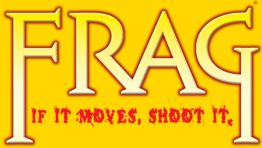


















 |
 |
 |
 |
 |
The game Frag, though fun and easy to learn, has a few potential problems with the rules. In this article, I would like to share the way that my friends and I have interpreted the rules and the justification for those interpretations. Until and unless Steve Jackson Games explicitly gives a conflicting interpretation or statement, these interpretations seem reasonable to us and could provide some help in the case of rules disputes and answers for people who like to play at being rules lawyers. However, please remember that these are only our opinions.
Justification: Weapons, when dropped, appear in the leftover pile for that square freshly loaded. Also, this is a "realified" computer game. If the computer "resets" the ammunition status of a single weapon, it seems reasonable to assume that it would also reset the linked status of a weapon and gadget combination. Besides, picking up a discarded Over/Under linking two Heavy Assault Cannons all in one turn creates a game-killing monster.
Justification: The exoskeleton provides extra speed and an extra Health point. The light and heavy armor provide one and two extra Health points, respectively. Since the exoskeleton behaves just like Light Armor, it must be armor, and the rule is that only one suit of armor can be worn at a time.
Justification: The card states "A miss is now considered a hit." Frag is a paper model of a computer game. Computers interpret commands literally. An out of range attack is still an attack, albeit an automatic miss. Interpreted literally, as a computer would, that miss is now a hit. Think of it as adding infinity to the Accuracy stat.
Quibble: Attacks through walls are misses. What about them?
Answer: Attacks through walls are not even permitted. The rules unequivocally state "Walls stop all movement and weapons effects."
Justification: In a computer game, it's usually impossible to shoot your character with a weapon he's holding. Entering an acid square does damage, and a player could choose to walk through acid squares until the cumulative damage frags him.
Caveat: Only entering the square activates the damage. If a character attempting suicide runs out of movement and is still alive, the suicide is not successful.
Note: Sometimes it's better to suicide and respawn far away from a player who's only one frag away from winning the game . . .
Justification: The Speed Boost gadget card states "Play at any time."
Caveat: You can only move during your turn, so playing it out of turn would usually be pointless and wasteful.
Justification: Speed and Health are attributes, and they're written with initial capital letters, making them names, not concepts. Therefore, they refer to character stats, not movement or damage.
Justification: Although the term "No Carrier" suggests that a character was disconnected from the game, the card states "That player is fragged instantly." The rules explicitly describe what happens when a player's character is fragged. Therefore, standard frag procedure is applied to that character.
Justification: The card states "Play immediately after an attack is rolled." While the phrase "rolling an attack" is not explicitly defined, if playing the card were permitted after the damage and protection dice are rolled, a player could choose whether or not to play the card based on the amount of damage actually done. It seems more reasonable to choose a more limiting definition of "rolling an attack" in order to make a better game.
Justification: Even though the card uses the phrase "acid attack," which suggests an intentional attack by another player, it seems more reasonable to dismiss this quibble as an attempt to take advantage of ambiguous phrasing. The concept of fireproof coating implies complete coverage against all flame and acid, regardless of its source.
Justification: The phrase "next turn" seems pretty clear. If your turn hasn't happened yet, the next time you get to play will be your "next turn." If it's your turn now, then you have to finish this turn and wait for another before it's your "next turn." Avoid thinking of the phrase "Discard after the end of your next turn" as meaning "good for two turns," for that way lies madness and confusion. Just remember what "next turn" means.
Commentary: Frag is a great game, and the rules are clearly written and easy to read. However, they were casually written, and have not been chewed over by rules lawyers to iron out possible quibbles by unreasonable players. Some rules were left slightly ambiguous, and some phrases were not precisely defined, such as "rolling an attack." For example, does it mean "rolling to see whether a hit was successful" or does it mean that plus "rolling for damage"?
Final bit of advice: Just have fun! Even if you could force a win by arguing with other players about exactly what a rule means, it just causes bad feelings all around. Besides, you might have been wrong! Even if you were right, it's often better to let something slide so that a more fun experience is had by all. What my friends and I do in case of disputes is to make a quick decision by consensus or vote, but then we note down the problem so it can be chewed over later. The interpretations given in this article are the results of that process applied over several games of Frag. If you and your friends truly enjoy wrangling over rules interpretations, however, you can safely ignore this advice.